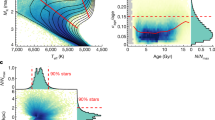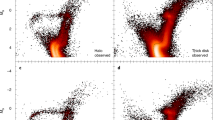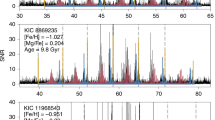Abstract
The Milky Way galaxy has several components, such as the bulge, disk and halo. Unravelling the assembly history of these stellar populations is often restricted because of difficulties in measuring accurate ages for low-mass, hydrogen-burning stars1,2. Unlike these progenitors, white dwarf stars3, the ‘cinders’ of stellar evolution, are remarkably simple objects and their fundamental properties can be measured with little ambiguity4,5. Here I report observations of newly formed white dwarf stars in the halo of the Milky Way, and a separate analysis of archival data in the well studied 12.5-billion-year-old globular cluster Messier 4. I measure the mass distribution of the remnant stars and invert the stellar evolution process to develop a mathematical relation that links this final stellar mass to the mass of their immediate progenitors, and therefore to the age of the parent population. By applying this technique to a small sample of four nearby and kinematically confirmed halo white dwarf stars, I calculate the age of local field halo stars to be 11.4 ± 0.7 billion years. The oldest globular clusters formed 13.5 billion years ago. Future observations of newly formed white dwarf stars in the halo could be used to reduce the uncertainty, and to probe relative differences between the formation times of the youngest globular clusters and the inner halo.
This is a preview of subscription content, access via your institution
Access options
Subscribe to this journal
Receive 51 print issues and online access
$199.00 per year
only $3.90 per issue
Buy this article
- Purchase on Springer Link
- Instant access to full article PDF
Prices may be subject to local taxes which are calculated during checkout


Similar content being viewed by others
References
Soderblom, D. R. The ages of stars. Annu. Rev. Astron. Astrophys. 48, 581–629 (2010)
Jofré, P. & Weiss, A. The age of the Milky Way halo stars from the Sloan Digital Sky Survey. Astron. Astrophys. 533, A59 (2011)
Paczyński, B. Evolution of single stars. I. Stellar evolution from main sequence to white dwarf or carbon ignition. Acta Astron. 20, 47–58 (1970)
Wegner, G. & Schulz, H. Spectroscopy of suspected peculiar DA white dwarfs. I—Equivalent widths and line profiles. Astron. Astrophys. 43 (Suppl.). 473–478 (1981)
Bergeron, P., Saffer, R. A. & Liebert, J. A spectroscopic determination of the mass distribution of DA white dwarfs. Astrophys. J. 394, 228–247 (1992)
Bedin, L. R. et al. The end of the white dwarf cooling sequence in M4: an efficient approach. Astrophys. J. 697, 965–979 (2009)
Kalirai, J. S. et al. A deep, wide-field, and panchromatic view of 47 Tuc and the SMC with HST: observations and data analysis methods. Astron. J. 143, 11 (2012)
Dotter, A. et al. The ACS survey of galactic globular clusters. IX. Horizontal branch morphology and the second parameter phenomenon. Astrophys. J. 708, 698–716 (2010)
Dotter, A. et al. The Dartmouth Stellar Evolution Database. Astrophys. J. 178 (Suppl.). 89–101 (2008)
Shapiro, S. L. & Teukolsky, S. A. Black Holes, White Dwarfs, and Neutron Stars: The Physics of Compact Objects 663 (Wiley-Interscience, 1983)
Tremblay, P.-E. & Bergeron, P. Spectroscopic analysis of DA white dwarfs: Stark broadening of hydrogen lines including nonideal effects. Astrophys. J. 696, 1755–1770 (2009)
Renzini, A. & Fusi Pecci, F. Tests of evolutionary sequences using color-magnitude diagrams of globular clusters. Annu. Rev. Astron. Astrophys. 26, 199–244 (1988)
Moehler, S. et al. Spectral types and masses of white dwarfs in globular clusters. Astron. Astrophys. 420, 515–525 (2004)
Oppenheimer, B. R. et al. Direct detection of galactic halo dark matter. Science 292, 698–702 (2001)
Gates, E. et al. Discovery of new ultracool white dwarfs in the Sloan Digital Sky Survey. Astrophys. J. 612, L129–L132 (2004)
Kilic, M. et al. Visitors from the halo: 11 Gyr old white dwarfs in the solar neighborhood. Astrophys. J. 715, L21–L25 (2010)
Napiwotzki, R. et al. Search for progenitors of supernovae type Ia with SPY. Astron. Nachr. 322, 411–418 (2001)
Pauli, E.-M. et al. 3D kinematics of white dwarfs from the SPY project. II. Astron. Astrophys. 447, 173–184 (2006)
Kalirai, J. S. et al. Stellar evolution in NGC 6791: mass loss on the red giant branch and the formation of low-mass white dwarfs. Astrophys. J. 671, 748–760 (2007)
Kalirai, J. S. et al. The initial-final mass relation: direct constraints at the low-mass end. Astrophys. J. 676, 594–609 (2008)
Kalirai, J. S. et al. The masses of population II white dwarfs. Astrophys. J. 705, 408–425 (2009)
Sarajedini, A. et al. The ACS survey of galactic globular clusters. I. Overview and clusters without previous Hubble Space Telescope photometry. Astron. J. 133, 1658–1672 (2007)
Dotter, A., Sarajedini, A. & Anderson, J. Globular clusters in the outer galactic halo: new Hubble Space Telescope/Advanced Camera for Surveys imaging of six globular clusters and the galactic globular cluster age-metallicity relation. Astrophys. J. 738, 74 (2011)
Carollo, D. et al. Two stellar components in the halo of the Milky Way. Nature 450, 1020–1025 (2007)
Beers, T. C. et al. The case for the dual halo of the Milky Way. Astrophys. J. 746, 34 (2012)
Zolotov, A. et al. The dual origin of stellar halos. Astrophys. J. 702, 1058–1067 (2009)
Font, A. S. et al. Cosmological simulations of the formation of the stellar haloes around disc galaxies. Mon. Not. R. Astron. Soc. 416, 2802–2820 (2011)
Tremblay, P.-E., Bergeron, P. & Gianninas, A. An improved spectroscopic analysis of DA white dwarfs from the Sloan Digital Sky Survey Data Release 4. Astrophys. J. 730, 128 (2011)
Acknowledgements
The data presented in this paper were obtained at the W. M. Keck Observatory, which is operated as a scientific partnership among the California Institute of Technology, the University of California and the National Aeronautics and Space Administration. The Observatory was made possible by the generous financial support of the W. M. Keck Foundation. I acknowledge the significant cultural role and reverence that the summit of Mauna Kea has within the indigenous Hawaiian community. I am fortunate to have had the opportunity to conduct observations from this mountain. This work was also based on observations obtained at the Paranal Observatory of the European Southern Observatory. I thank A. Dotter, P. Bergeron, and P.-E. Tremblay for discussions related to stellar evolution and ages. I also thank U. Heber for providing us reduced spectra from the SPY Survey.
Author information
Authors and Affiliations
Corresponding author
Ethics declarations
Competing interests
The author declares no competing financial interests.
PowerPoint slides
Rights and permissions
About this article
Cite this article
Kalirai, J. The age of the Milky Way inner halo. Nature 486, 90–92 (2012). https://doi.org/10.1038/nature11062
Received:
Accepted:
Published:
Issue Date:
DOI: https://doi.org/10.1038/nature11062
This article is cited by
-
Galaxy formation: The new Milky Way
Nature (2012)
-
Young dwarfs date an old halo
Nature (2012)
-
Erratum: Corrigendum: The age of the Milky Way inner halo
Nature (2012)
Comments
By submitting a comment you agree to abide by our Terms and Community Guidelines. If you find something abusive or that does not comply with our terms or guidelines please flag it as inappropriate.



